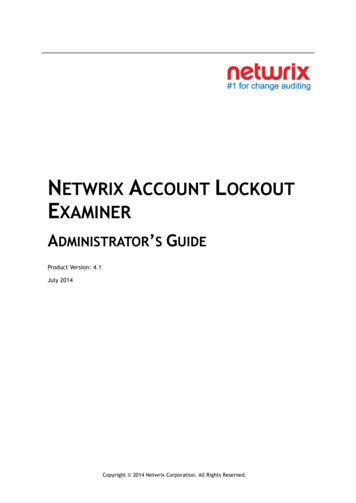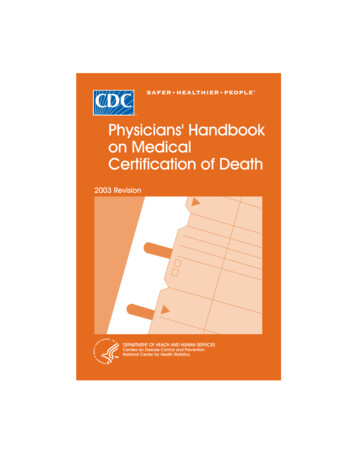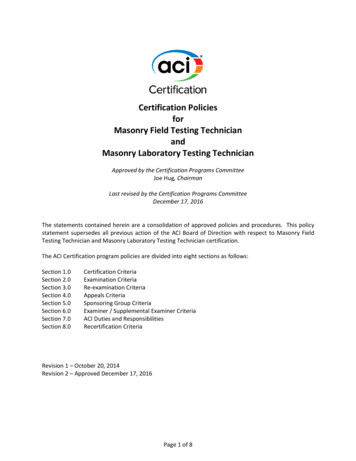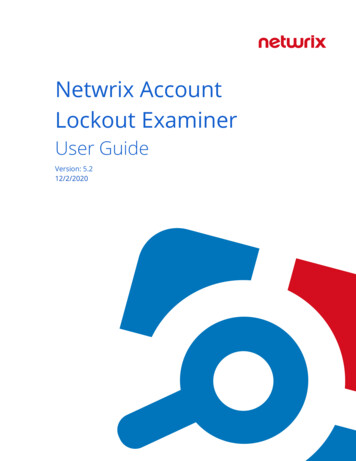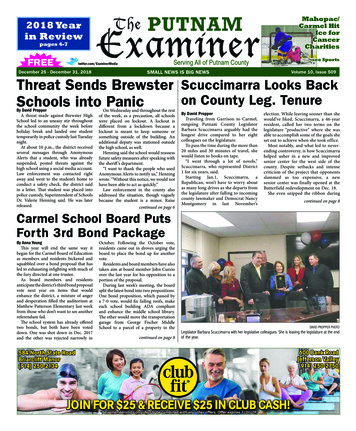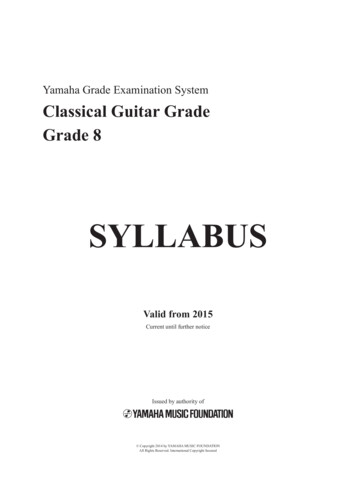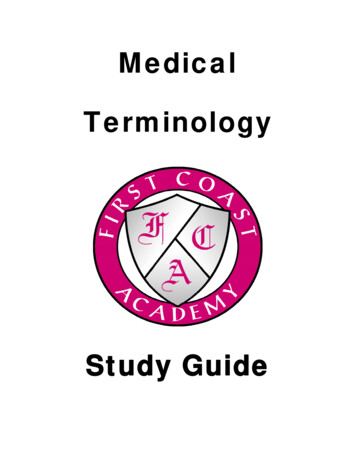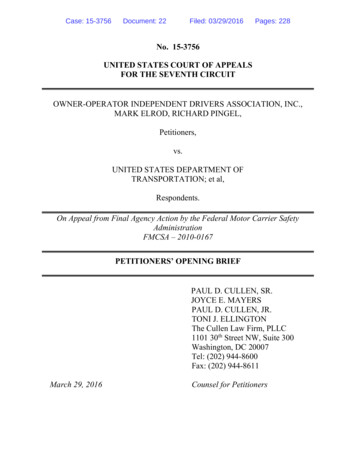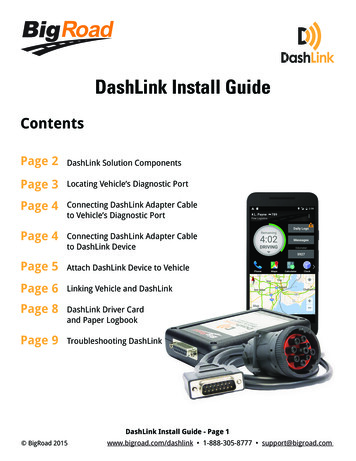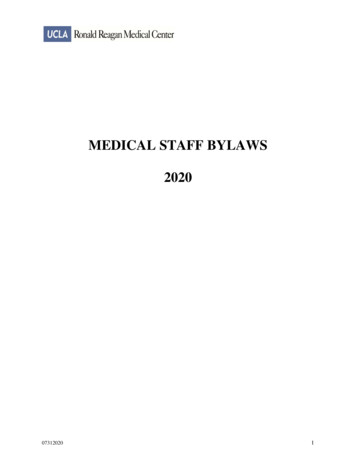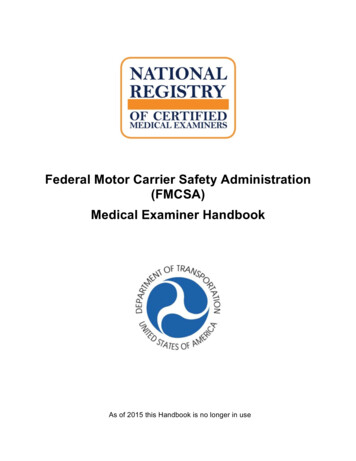
Transcription
Federal Motor Carrier Safety Administration(FMCSA)Medical Examiner HandbookAs of 2015 this Handbook is no longer in use
Table of ContentsIntroduction . 7Part I – The Federal Motor Carrier Safety Administration (FMCSA) . 8About the FMCSA . 8FMCSA Mission Statement . 8About the Office of Medical Programs . 8The Office of Medical Programs Mission Statement . 8About the National Registry of Certified Medical Examiners . 9The National Registry of Certified Medical Examiners Mission Statement . 9The Medical Examiner . 9Medical Certification. 10Privacy and the Medical Examination . 10Medical Examination Report Form. 10Medical Examiner’s Certificate. 11Medical Regulations Summary . 11Code of Federal Regulations — LAW . 11Medical Standards/Advisory Criteria/Guidelines . 12Medical Regulations Summary Table . 12Exemptions . 14Important Definitions . 14Regulation Definitions . 14Part II - The Job of Commercial Driving . 16FMCSA Regulates Interstate Commercial Operation . 16Drivers. 16Vehicles. 16Truck and Bus Companies. 16State Regulations. 17The Driver and the Job of Commercial Driving . 17The Driver . 17The Job of Commercial Driving. 18FMCSA Commercial Driving Facts and Research . 20Office of Analysis, Research, and Technology . 20Part III - Medical Examination Guidelines . 23About 49 CFR 391.43 . 23Purpose of Interstate Commercial Driver Physical Examination. 23Driver/Medical Examiner Relationship . 23Purpose of Physical Examination. 23The Issue Is Risk. 23Consider Safety Implications. 24Page 2 of 260
Medical Examiner Do's . 24Medical Examination Report Form - Overview . 25Driver Information. 26Health History. 27Vision . 33Hearing. 34Blood Pressure/Pulse. 36Urinalysis. 38Physical Examination . 39Determine Certification Status . 43Certify. 44Disqualify. 48Issue Medical Examiner's Certificate . 49Part IV - Physical Qualification Standards and Advisory Criteria . 51Physical Qualification Standards (Regulations) versus Advisory Criteria (Medical Guidelines) . 51Ongoing Standards and Guidelines Review Process . 51About 49 CFR 391.41 . 52Vision . 52Vision Regulation 49 CFR 391.41(b)(10) . 52Health History and Physical Examination . 53Certification and Documentation . 56Hearing. 59Hearing Regulation 49 CFR 391.41(b)(11) . 60Health History and Physical Examination . 60Certification and Documentation . 62Advisory Criteria/Guidance . 63Hypertension . 64Blood Pressure (BP) Regulations 49 CFR 391.41(b)(6) and 49 CFR 391.43(f) . 65Health History and Physical Examination . 65Advisory Criteria/Guidance . 67Cardiovascular . 73Cardiovascular Regulation 49 CFR 391.41(b)(4). 73Health History and Physical Examination . 74Advisory Criteria/Guidance . 75Respiratory (b)(5) . 117Respiratory Regulation 49 CFR 391.41(b)(5) . 118Health History and Physical Examination . 118Advisory Criteria/Guidance . 120Neurological (b)(7)(8)(9). 136Page 3 of 260
Neurological Regulations 49 CFR 391.41(b)(7)(8)(9) . 137Health History and Physical Examination . 138Advisory Criteria/Guidance . 140Musculoskeletal (b)(1)(2)(7) . 167Musculoskeletal Regulations 49 CFR 391.41(b)(1)(2)(7). 167Health History and Physical Examination . 168Advisory Criteria/Guidance . 170Diabetes Mellitus. 172Diabetes Mellitus Regulation 49 CFR 391.41(b)(3) . 173Health History and Physical Examination . 173Advisory Criteria/Guidance . 175Other Diseases . 181Other Diseases Regulation 49 CFR 391.41(b)(9) . 182Health History and Physical Examination . 182Advisory Criteria/Guidance . 183Psychological Disorders (b)(9) . 185Psychological Regulation 49 CFR 391.41(b)(9). 186Health History and Physical Examination . 186Advisory Criteria/Guidance . 189Drug Abuse and Alcoholism. 201Drug Abuse and Alcoholism Regulations 49 CFR 391.41(b)(12)(13) . 202Health History and Physical Examination . 202About 49 CFR 382 Alcohol and Drug Rules. 204Advisory Criteria/Guidance . 205Medications/Drug Use 49 CFR 391.41(b)(12) . 208Medications/Drug Use Regulation 49 CFR 391.41(b)(12) . 208Health History and Physical Examination . 209Advisory Criteria/Guidance . 211Appendix A: Medical Examination Report Form . 213Medical Examination Report Form - Page 1 . 213Driver Information. 213Health History. 213Medical Examination Report Form - Page 2 . 213Vision . 213Hearing. 214Blood Pressure/Pulse. 214Urinalysis. 214Medical Examination Report Form - Page 3 . 215Physical Examination . 215Page 4 of 260
Certification and Documentation . 215Appendix B: Federal Exemption Programs . 21749 CFR 381.300 What is an exemption? . 217Federal Vision Exemption Program . 217Qualified by Operation of 49 CFR 391.64: "Grandfathered" . 217Federal Diabetes Exemption Program . 218About the Federal Diabetes Exemption Program. 218Relevance to Driving . 219Health History and Physical Examination . 219Appendix C: Skill Performance Evaluation . 223Fixed Deficit of an Extremity . 223Appendix D: Cardiovascular Recommendation Tables . 225Preface. 225ANEURYSMS . 226AORTIC CONGENITAL HEART DISEASE . 227AORTIC CONGENITAL HEART DISEASE (Continued). 228AORTIC REGURGITATION. 229AORTIC STENOSIS . 230ATRIAL SEPTAL DEFECTS . 231ATRIAL SEPTAL DEFECTS (Continued) . 232ATRIAL SEPTAL DEFECTS (Continued) . 233BUNDLE BRANCH BLOCKS AND HEMIBLOCKS. 234CARDIOMYOPATHIES AND CONGESTIVE HEART FAILURE (CHF) . 235COMMERCIAL DRIVERS WITH KNOWN CORONARY HEART DISEASE (CHD) . 236COMMERCIAL DRIVERS WITH KNOWN CORONARY HEART DISEASE (CHD) (Continued) . 237COMMERCIAL DRIVERS WITHOUT KNOWN CORONARY HEART DISEASE (CHD) . 238CONGENITAL HEART DISEASE . 239CONGENITAL HEART DISEASE (Continued) . 240CONGENITAL HEART DISEASE (Continued) . 241CONGENITAL HEART DISEASE (Continued) . 242CONGENITAL HEART DISEASE (Continued) . 243HEART TRANSPLANTATION . 244HYPERTENSION. 245IMPLANTABLE DEFIBRILLATORS. 246MITRAL REGURGITATION . 247MITRAL STENOSIS. 248PACEMAKERS . 249PACEMAKERS (Continued) . 250PACEMAKERS (Continued) . 251Page 5 of 260
PERIPHERAL VASCULAR DISEASE . 252SUPRAVENTRICULAR TACHYCARDIAS . 253SUPRAVENTRICULAR TACHYCARDIAS (Continued) . 254VALVE REPLACEMENT . 255VALVE REPLACEMENT (Continued). 256VENOUS DISEASE . 257VENTRICULAR ARRHYTHMIAS. 258VENTRICULAR ARRHYTHMIAS (Continued). 259VENTRICULAR SEPTAL DEFECTS . 260Page 6 of 260
IntroductionThis handbook provides information and guidance to the medical examiner who performs the commercialdriver medical examination. Determining driver medical fitness for duty is a critical element of the FMCSAsafety program. Specialists, such as cardiologists and endocrinologists, may perform additional medicalevaluation, but it is the medical examiner who decides if the driver is medically qualified to drive.Page 7 of 260
Part I – The Federal Motor Carrier Safety Administration (FMCSA)About the FMCSAOn December 9, 1999, President Clinton signed into law the Motor Carrier Safety Improvement Act of1999. This act transferred the Office of Motor Carriers from the Federal Highway Administration (FHWA)to establish the Federal Motor Carrier Safety Administration (FMCSA). FMCSA is one of nine U.S.Department of Transportation administrations. To learn more, visit the DOT Agencies Web page athttp://www.dot.gov/DOTagencies.htm.FMCSA is headquartered in Washington, DC and employs people in all 50 States and the District ofColumbia. FMCSA is led by an Administrator, Deputy Administrator, and Chief Safety Officer. The Officeof Medical Programs is located under the Associate Administrator for Policy and Program Development.FMCSA partners and customers are serviced by field organizations. The organizations consist of FieldOperations, Service Centers, and State-level motor carrier division offices.FMCSA activities contribute to ensuring safety in motor carrier operations through strong enforcement ofsafety regulations; targeting high-risk carriers and commercial motor vehicle drivers; improving safetyinformation systems and commercial motor vehicle technologies; strengthening commercial motor vehicleequipment and operating standards; and increasing safety awareness.FMCSAMission Statement"The Federal Motor Carrier Safety Administration (FMCSA) is focused on reducing crashes,injuries, and fatalities involving large trucks and buses."In carrying out its safety mandate to reduce crashes, injuries, and fatalities involving large trucks andbuses, FMCSA: Develops and enforces data-driven regulations that balance motor carrier (truck and buscompanies) safety with industry efficiency. Harnesses safety information systems to focus on higher-risk carriers in enforcing safetyregulations. Targets educational messages to carriers, commercial drivers, and the public. Partners with stakeholders including Federal, State, and local enforcement agencies, the motorcarrier industry, safety groups, and organized labor on efforts to reduce bus and truck-relatedcrashes.To learn more about FMCSA, visit http://www.fmcsa.dot.gov/about/aboutus.aspx.About the Officeof Medical ProgramsThe Office of Medical Programs Mission Statement"The mission of the Office of Medical Programs is to promote the safety of America's roadwaysthrough the promulgation and implementation of medical regulations, guidelines and policies thatensure commercial motor vehicle drivers engaged in interstate commerce are physically qualifiedto do so."Page 8 of 260
To promote safety, the Office of Medical Programs: Oversees the national medical certification process for commercial motor vehicle drivers whooperate in interstate commerce. Develops and implements medical regulations, policies, and procedures. Oversees and supports the Medical Review Board in accordance with the Federal AdvisoryCommittee Act. Develops and implements the national registry program — a national medical examiner systemand a linked national driver medical reporting system. Conducts and oversees the Agency's medical exemption and certificate programs. Serves as the lead Federal agency for the regulation of commercial motor vehicle driver healthand safety and conducts relevant medical research.To learn more about the Office of Medical Programs, visit edical/medical.htm.About the National Registry of Certified Medical ExaminersThe National Registry of CertifiedMedical Examiners Mission Statement"The primary mission of the National Registry of Certified Medical Examiners is to improvehighway safety by producing trained, certified medical examiners who can effectively determine ifa commercial motor vehicle driver's health meets Federal Motor Carrier Safety Administrationstandards."FMCSA has begun the rulemaking process for proposing the National Registry of Certified MedicalExaminers (NRCME) program.The certified medical examiner would: Demonstrate an understanding of FMCSA physical qualification requirements and the demandsof commercial driving, driver tasks, and the work environment. Perform driver certification examinations in accordance with FMCSA physical qualificationrequirements and medical guidelines.To learn more about the National Registry of Medical Examiners, visithttps://nationalregistry.fmcsa.dot.gov.The Medical ExaminerThe Federal Motor Carrier Safety Regulations identify a person who can be a medical examiner by twocriteria: professional licensure and scope of practice that includes performing physical examinations.Medical examiner means a person who is licensed, certified, and/or registered, in accordance withapplicable State laws and regulations, to perform physical examinations. The term includes, but is notlimited to, doctors of medicine and osteopathy, advanced practice nurses, physician assistants andchiropractors.When the Federal Motor Carrier Safety Administration (FMCSA) completes the notice-and-commentrulemaking for the proposed National Registry of Certified Medical Examiners, healthcare professionalswill be required to be trained and certified and listed on a national registry to perform physicalexaminations of truck and bus drivers. At this time, FMCSA does not endorse any medical examinerPage 9 of 260
training, education or certification programs, and healthcare professionals are not required to be listed ona registry or other database to perform driver physical examinations.Medical CertificationMedical certification in accordance with Federal Motor Carrier Safety Administration (FMCSA) physicalqualification standards is required when the driver is operating a commercial vehicle in interstatecommerce that: Has a combined gross vehicle weight or weight rating of 10,001 lbs. or more. Is designed or used to transport 9-15 passengers (including the driver) for compensation. Is designed or used to transport 16 or more passengers (including the driver) whether forcompensation or not. Transports hazardous materials in quantities that require placarding under the hazardousmaterials regulations.When a driver returns from an illness or injury that interferes with driving ability, the driver must undergo amedical examination even if the medical examiner's certificate has not expired.The medical examiner is responsible for certifying only drivers who meet the physical qualificationstandards. Certification cannot exceed 2 years, and at the discretion of the FMCSA medical examiner,may be less than 2 years. The Federal Vision and Diabetes Exemption Programs require annual medicalcertification.The medical examiner's certificate expires at midnight of the day, month, and year written on thecertificate. There is no grace period on the expiration. The driver must be re-examined and recertified tocontinue to drive legally.Privacy and the Medical ExaminationRegulatory requirements take prec
This handbook provides information and guidance to the medical examiner who performs the commercial driver medical examination. Determining driver medical fitness for duty is a critical element of the FMCSA safety program. Specialists, such as cardiolog
